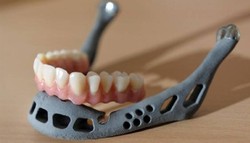3D printing utilizes a large variety of materials. There are several large 3D printing companies that focus on expanding this technology - and they do it by providing new advances in the material science behind 3D printing. Whether you're looking to "manufacture" a unique ornament for your Christmas tree, or you are thinking about creating a scaled jet engine & need a material which can withstand high temperatures, this technology is likely for you!

The Variety Of 3D Printing
by cwaldo39
If you've been involved with manufacturing, you've probably heard of 3D printing. In this article I'm going to cover some of the basic material science involved.
What To Consider When Choosing A Material For 3D Printing
What's the best material?
Alright, you finally finished designing that awesome model. It took you 30 hours to do it, and you want to hold the final piece in your hand. Wait, what's next? You've already taken care of the hard part, but how do you know what to print your model in?

Quite a few variables come into play when choosing a material for your model, so you may want to take these points into consideration when looking for a material. There is going to be a significant difference when choosing a material for a model which focuses on "arts and crafts" and a model which focuses on "aerospace engineering." Just keep in mind, there is going to be quite a bit of variance between models.
Here are a few aspects to take into consideration
Price
Not every material costs the same! If you're looking to print a model at a resolution around 13 microns (about 1/4th of the diameter of a single hair). Printing in titanium is probably going to cost you as well. However, an inexpensive ABS plastic might be a better option - or perhaps full color sandstone?
Model Intricacy
There are several forms of 3D printing out there - and not all of them do exactly the same thing. Some processes involve ultraviolet light curing material to harden it, and some involves simply laying down melted material. There are quite a few styles of 3D printing, but keep in mind - some materials are exclusive to certain styles of 3D printing.
If you need to produce a model that has super high resolution like I mentioned earlier, you probably won't be producing parts with sandstone like composites. If you need to create a model with a seriously intricate center, you probably won't be using a material which uses a lot of support material.
Resolution
 Perhaps you want to create something such as an intricate ring or piece of jewelry. If you're doing something very detailed, you will likely use a wax-like material intended for casting, or perhaps you'll directly print the metal. You would have a very difficult time producing jewelry from low-resolution materials such as ceramics. Casting with a sandstone like material or plastic would be extremely difficult, and the material may not burn out correctly. Maybe you just want to produce a simple iPhone case; if so, you probably wouldn't need anything too flashy.
Perhaps you want to create something such as an intricate ring or piece of jewelry. If you're doing something very detailed, you will likely use a wax-like material intended for casting, or perhaps you'll directly print the metal. You would have a very difficult time producing jewelry from low-resolution materials such as ceramics. Casting with a sandstone like material or plastic would be extremely difficult, and the material may not burn out correctly. Maybe you just want to produce a simple iPhone case; if so, you probably wouldn't need anything too flashy.
Texture / Surface
 If you're looking to prototype a phone or video game controller, you'll likely need to use a material which has a rubber-like feel to it for the buttons. If so, you may want to look at Objet's Tango family. Maybe you want something that's very smooth and clean - perhaps ceramic material is for you. There are quite a few options for materials with smooth finishes. There are also a few rugged ones as well. It's all preference, really.
If you're looking to prototype a phone or video game controller, you'll likely need to use a material which has a rubber-like feel to it for the buttons. If so, you may want to look at Objet's Tango family. Maybe you want something that's very smooth and clean - perhaps ceramic material is for you. There are quite a few options for materials with smooth finishes. There are also a few rugged ones as well. It's all preference, really.
Special Material Characteristics
 Some products have very specific needs for their products. Perhaps you need a certain plastic to be resistant to heat. Maybe you need a very strong metal to withstand impact. Other materials offer chemical resistance in some instances. Maybe a material needs to operate under pressure. There's a material for pretty much everything.
Some products have very specific needs for their products. Perhaps you need a certain plastic to be resistant to heat. Maybe you need a very strong metal to withstand impact. Other materials offer chemical resistance in some instances. Maybe a material needs to operate under pressure. There's a material for pretty much everything.
In Conclusion
So now what?
If you can create a 3D image on the computer, it's more than likely that you can print it! Asking yourself a few key questions might help you with picking a material: What's my budget? What kind of detail do I need? How intricate is my model? Does it need to have a certain finish? Does it need to be strong or flexible? Do I need any special material characteristics?
There are over a hundred materials to choose from, the decision just comes down to the budget you're looking at, the demands of your model, and its intended use. There's a material available for pretty much whatever you need!
If you're interested in manufacturing one of your models through 3D printing, feel free to upload your model and get an instant quote.
You might also like
Telechron Vintage Alarm ClockYears ago I became obsessed with Telechron clocks. I still have most of them ...
Food Printer. That's Right. They Are Making Food PrintableIn the not so distant future, you may be shopping online for a new type of "f...





Comments